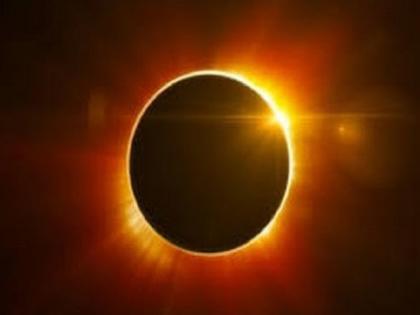Rare Total Solar Eclipse to Darken Skies Over Europe, Africa & Middle East on August 2, 2027
By Lokmat English Desk | Updated: July 22, 2025 16:59 IST2025-07-22T16:57:49+5:302025-07-22T16:59:13+5:30
A rare and beautiful celestial body movement, called total solar eclipse is set to occur on August 2, 2027. ...

Rare Total Solar Eclipse to Darken Skies Over Europe, Africa & Middle East on August 2, 2027
A rare and beautiful celestial body movement, called total solar eclipse is set to occur on August 2, 2027. The solar eclipse will be visible in parts of Europe,North Africa, and the Middle East. This time, the unusual part of this event will be its duration. This solar eclipse will last for 6 minutes 23 seconds. As per the Metro report,this will be the longest duration of a solar eclipse from 1991 and 2114. Hence, it will be marked as a significant celestial event of the century.
Solar Eclipse 2027:
The 2027 total solar eclipse is a rare event where the Sun will completely disappear behind the moon. This will lead to creation of a moment known as totality. When the Moon will block the Sun’s light a line of totality will move across the world slowly. It will bring darkness to the daytime sky for a short time. This totality part will cover the parts of southern Europe and northern Africa. Approximately 89 million people live in this region.
Countries like Morocco, Algeria, Tunisia, Libya, Egypt, Sudan, Saudi Arabia, Yemen, and Somalia will all be able to observe this occurrence. Greg Brown, a senior astronomer at the Royal Museums Greenwich, said the eclipse will last six minutes, which is a very lengthy time for a celestial event of that magnitude. It ranges from a theoretical maximum of 7.5 minutes to a minimum of just a few seconds. Because of their slightly shifting distances from one another during the Moon's orbit around the Earth and the Earth's orbit around the Sun, the Moon and Sun appear to vary in size, which is the cause of this variation, Mr. Brown stated.
A solar eclipse happens when the Moon completely or partially blocks the Sun's light as it moves directly between the Earth and the Sun. Only when the Moon is between the Earth and the Sun, during a new moon, can this occur. The Moon typically passes above or below the Sun in the sky due to its tilted orbit, making solar eclipses comparatively uncommon.
There are three categories of solar eclipses:
1. Total Solar Eclipse: The Sun's corona is visible when the Moon totally blocks the Sun's light.
2. Partial Solar Eclipse: A partial shadow is cast on Earth when the Moon partially obscures the Sun.
3. Annular Solar Eclipse: A ring of light surrounds the Moon as it appears smaller than the Sun.
Open in app